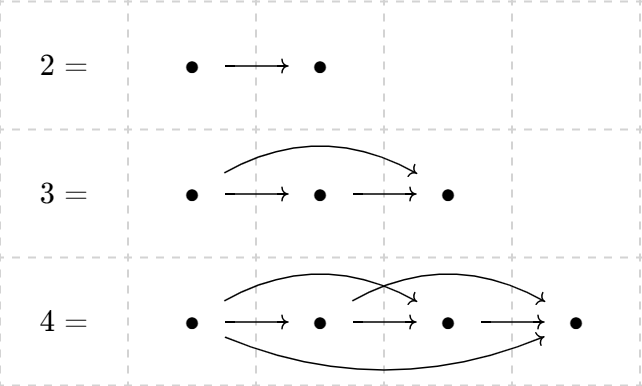Acknowledgements: ChatGPT for Grammar fixing.
In mathematics, ordinals extend the concept of counting beyond finite numbers and incorporate infinite sequences. From a graph theory perspective, you can think of ordinals as a hierarchy of "layers" or "levels" that represent different sizes and types of infinity.
Basic Concepts
In this blog, we define ordinals as competitive graphs $$$\Gamma$$$, where a competitive graph is a directed graph in which exactly one of $$$(u, v)$$$ or $$$(v, u)$$$ is included in the edge set for every pair of distinct vertices $$$u$$$ and $$$v$$$. These graphs are characterized by the absence of loops and reversed rays, where a reversed ray refers to a sequence of vertices $$$v_0, v_1, v_2, \dots$$$ with edges $$$(v_1, v_0), (v_2, v_1), (v_3, v_2), \dots$$$.
Finite ordinals correspond to natural numbers. For instance, $$$0$$$ represents the empty graph, and $$$1$$$ denotes the graph with a single vertex. An example is provided below:

In fact, the set of natural numbers $$$\mathbb{Z}_{\ge 0}$$$, often denoted as $$$\omega$$$, can be interpreted as an ordinal: $$$\Gamma_\omega = (V, E)$$$, where $$$V = \mathbb{Z}_{\ge 0}$$$ and $$$E = \{(i, j) : i < j\}$$$. However, $$$\mathbb{Z}$$$ cannot be considered an ordinal in a similar manner, due to the presence of a reversed ray, as exemplified by the sequence of vertices $$$v_i = -i$$$.
We define $$$\alpha \le \beta$$$ if $$$\beta$$$ can be viewed as a subgraph of $$$\alpha$$$. Similarly, $$$\alpha = \beta$$$ if and only if $$$\alpha \le \beta$$$ and $$$\beta \le \alpha$$$. As is familiar, the relationship between ordinals is either $$$\alpha < \beta$$$, $$$\alpha = \beta$$$, or $$$\alpha > \beta$$$.
In fact, for every set $$$A$$$ of ordinals, there exists an ordinal $$$\min A$$$ in the set $$$A$$$. The proof is straightforward: one can obtain $$$\min A$$$ by taking the union of all the $$$S_\alpha$$$, where $$$\alpha \in A$$$ and $$$S$$$ is the set defined previously.
The successor of an ordinal $$$\alpha$$$ is a new graph $$$G$$$ where the vertices include all the vertices of $$$\alpha$$$ along with an additional vertex $$$v$$$. All edges $$$(w, v)$$$, where $$$w$$$ is a vertex in $$$\alpha$$$, are added. The successor of $$$\alpha$$$ is denoted as $$$\alpha^+$$$. It is evident that $$$\alpha < \alpha^+$$$. Consequently, we can define the $$$n$$$-th successor of $$$\alpha$$$, denoted as $$$\alpha + n$$$.
To understand how addition and multiplication of ordinals work, consider the following definitions: For ordinals $$$\alpha$$$ and $$$\beta$$$, $$$\alpha + \beta$$$ is the ordinal with vertices formed by the disjoint union $$$\alpha \sqcup \beta$$$ (where $$$\sqcup$$$ denotes the disjoint union of sets) and edges of three types: the edges from $$$\alpha$$$ itself, the edges from $$$\beta$$$ itself, and new edges $$$(u, v)$$$ where $$$u$$$ is a vertex of $$$\alpha$$$ and $$$v$$$ is a vertex of $$$\beta$$$. Similarly, $$$\alpha \times \beta$$$ is the ordinal with vertices formed by pairs $$$(u, v)$$$, and edges formed by pairs $$$((u, v), (u', v'))$$$, where either $$$(u, u') \in E_\alpha$$$ or $$$u = u'$$$ and $$$(v, v') \in E_\beta$$$.
It is important to note that commutativity does not hold for ordinals: $$$1 + \omega = \omega \ne \omega + 1$$$, and $$$2 \omega = \omega \ne \omega 2$$$. However, associativity does hold.
Here are some properties of ordinals:
- If $$$\beta < \gamma$$$, then $$$\alpha + \beta < \alpha + \gamma$$$.
- If $$$\alpha < \beta$$$, there exists a unique $$$\gamma$$$ such that $$$\alpha + \gamma = \beta$$$.
- For ordinals $$$\gamma$$$ and $$$\alpha$$$, there exists a unique pair of ordinals $$$\beta$$$ and $$$\delta$$$ such that $$$\gamma = \alpha \beta + \delta$$$.
- For $$$\gamma > 0$$$, there exists a unique Cantor normal form $$$\gamma = \omega^{\alpha_1} k_1 + \dots + \omega^{\alpha_n} k_n$$$, where $$$n \ge 1$$$, $$$\alpha_1 > \alpha_2 > \dots > \alpha_n$$$ are ordinals, and $$$k_1, k_2, \dots, k_n \in \mathbb{Z}_{> 0}$$$.
Application in CP/OI
Consider a directed graph $$$\Gamma$$$ and the SG (Sprague-Grundy) function $$$f$$$ defined on it. If $$$\Gamma$$$ is finite, $$$f$$$ can be easily represented as a natural number-valued function. However, when we extend the SG function to handle infinite graphs, we need to incorporate ordinals.
For instance, in problem 1149E - Election Promises, we observe that a state can have infinitely many successors. To illustrate this, consider the special case where the graph is $$$1 \to 2$$$.
- If $$$h_1 = 0$$$, then the SG function is $$$h_2$$$, which can be directly verified.
- If $$$h_1 = 1$$$ and $$$h_2 = 0$$$, the successors are every state $$$0 \to n$$$, where $$$n$$$ is a natural number. Consequently, the SG function for the state $$$h_1 = 1$$$ and $$$h_2 = 0$$$ is $$$\omega$$$, as $$$\omega$$$ is the smallest ordinal not included in $$$\mathbb{N}$$$.
Continuing this pattern, for general values $$$h_1$$$ and $$$h_2$$$, we find that the SG function is given by $$$\omega h_1 + h_2$$$.
More generally, for any directed graph $$$\Gamma$$$ considered as a normal directed graph game, the SG function $$$\sigma$$$ can be expressed in terms of ordinals. Specifically, the SG function can be written as
where the coefficients $$$a_k$$$ are given by
By fundamental principles in game theory, a game is a P-position (a position from which the second player has a winning strategy) if and only if its SG function is non-zero. This completes the discussion of the problem.
An another example is 最长待机 / Longest Standby.
Try to solve it yourself! :) After solving it you can understand why $$$1 + \omega \ne \omega + 1$$$.











Auto comment: topic has been updated by OIer1048576 (previous revision, new revision, compare).
easy solution :clown:
Auto comment: topic has been updated by OIer1048576 (previous revision, new revision, compare).